Upgrade
On this page, you find all documents, package deals, and flashcards offered by seller upgrade.
- 231
- 0
- 19
Community
- Followers
- Following
250 items
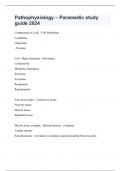
Pathophysiology – Paramedic study guide 2024
Components of a cell - Cell Membrane Cytoplasm Organelles - Nucleus Cell - Major functions - Movement Conductivity Metabolic absorption Secretion Excretion Respiration Reproduction Four tissue types - Connective tissue Nervous tissue Muscle tissue Epithelial tissue Muscle tissue example - Skeletal muscle - voluntary Cardiac muscle Smooth muscle - involuntary (intestines and surrounding blood vessels) Epithelial tissue - example - Lining - skin, mucous membranes, ...
- Exam (elaborations)
- • 11 pages •
Components of a cell - Cell Membrane Cytoplasm Organelles - Nucleus Cell - Major functions - Movement Conductivity Metabolic absorption Secretion Excretion Respiration Reproduction Four tissue types - Connective tissue Nervous tissue Muscle tissue Epithelial tissue Muscle tissue example - Skeletal muscle - voluntary Cardiac muscle Smooth muscle - involuntary (intestines and surrounding blood vessels) Epithelial tissue - example - Lining - skin, mucous membranes, ...
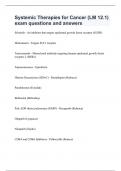
Systemic Therapies for Cancer (LM 12.1) exam questions and answers
Erlotinib - An inhibitor that targets epidermal growth factor receptor (EGFR) Midostaurin - Targets FLT3 receptor Transuzumab - Monoclonal antibody targeting human epidermal growth factor receptor 2 (HER2) Topoisomerases - Epirubicin Histone Deacetylase (HDAC) - Romidepsin (Rubraca) Panobinostat (Farydak) Belinostat (Beleodaq) Poly ADP ribose polymerase (PARP) - Rucaparib (Rubraca) Olaparib (Lynparza) Niraparib (Zejula) CDK4 and CDK6 Inhibitors - Palbociclib (Ibranc...
- Exam (elaborations)
- • 5 pages •
Erlotinib - An inhibitor that targets epidermal growth factor receptor (EGFR) Midostaurin - Targets FLT3 receptor Transuzumab - Monoclonal antibody targeting human epidermal growth factor receptor 2 (HER2) Topoisomerases - Epirubicin Histone Deacetylase (HDAC) - Romidepsin (Rubraca) Panobinostat (Farydak) Belinostat (Beleodaq) Poly ADP ribose polymerase (PARP) - Rucaparib (Rubraca) Olaparib (Lynparza) Niraparib (Zejula) CDK4 and CDK6 Inhibitors - Palbociclib (Ibranc...
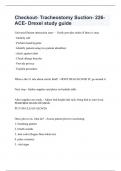
Checkout- Tracheostomy Suction- 226- ACE- Drexel study guide
Universal Patient interaction start - · Verify provider order (if there is one) · Identify self · Perform hand hygiene · Identify patient using two patient identifiers - check against chart · Check allergy bracelet · Provide privacy · Explain procedure What is the #1 rule about sterile field? - DONT REACH OVER IT, go around it Next step - Gather supplies and place on bedside table After supplies are ready, - Adjust bed height/side rails, bring bed to your level, PERFORM HA...
- Exam (elaborations)
- • 6 pages •
Universal Patient interaction start - · Verify provider order (if there is one) · Identify self · Perform hand hygiene · Identify patient using two patient identifiers - check against chart · Check allergy bracelet · Provide privacy · Explain procedure What is the #1 rule about sterile field? - DONT REACH OVER IT, go around it Next step - Gather supplies and place on bedside table After supplies are ready, - Adjust bed height/side rails, bring bed to your level, PERFORM HA...
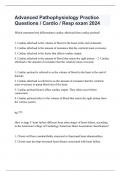
Advanced Pathophysiology Practice Questions / Cardio / Resp exam 2024
Which statement best differentiates cardiac afterload from cardiac preload? 1. Cardiac afterload is the volume of blood in the heart at the end of diastole. 2. Cardiac afterload is the amount of resistance that the ventricle must overcome. 3. Cardiac afterload is the factor that affects cardiac output. 4. Cardiac afterload is the amount of blood that enters the right atrium. - 2. Cardiac afterload is the amount of resistance that the ventricle must overcome. 1. Cardiac preload is referr...
- Exam (elaborations)
- • 75 pages •
Which statement best differentiates cardiac afterload from cardiac preload? 1. Cardiac afterload is the volume of blood in the heart at the end of diastole. 2. Cardiac afterload is the amount of resistance that the ventricle must overcome. 3. Cardiac afterload is the factor that affects cardiac output. 4. Cardiac afterload is the amount of blood that enters the right atrium. - 2. Cardiac afterload is the amount of resistance that the ventricle must overcome. 1. Cardiac preload is referr...
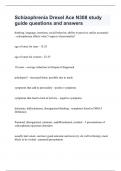
Schizophrenia Drexel Ace N308 study guide questions and answers
thinking, language, emotions, social behavior, ability to perceive reality accurately - schizophrenia effects what 5 aspects of personality? age of onset for men - 15-25 age of onset for women - 25-35 10 years - average reduction in lifespan if diagnosed polydipsia? - increased thirst, possibly due to meds symptoms that add to personality - positive symptoms symptoms that lead to lack of activity - negative symptoms delusions, hallucinations, disorganized thinking - symptoms...
- Exam (elaborations)
- • 2 pages •
thinking, language, emotions, social behavior, ability to perceive reality accurately - schizophrenia effects what 5 aspects of personality? age of onset for men - 15-25 age of onset for women - 25-35 10 years - average reduction in lifespan if diagnosed polydipsia? - increased thirst, possibly due to meds symptoms that add to personality - positive symptoms symptoms that lead to lack of activity - negative symptoms delusions, hallucinations, disorganized thinking - symptoms...
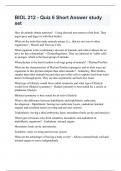
BIOL 212 - Quiz 6 Short Answer study set
How do animals obtain nutrients? - Using directed movement to find food. Then ingest prey and digest it with their bodies. What are the traits that make animals unique (i.e., that are not seen in other organisms)? - Muscle and Nervous Cells What organism is the evolutionary ancestor of animals, and what evidence do we have for this relationship? - Choanoflagellates. They are identical to "collar cells" in sponges, which is the basal group of animals. What phylum is the basal (earliest evolv...
- Exam (elaborations)
- • 4 pages •
How do animals obtain nutrients? - Using directed movement to find food. Then ingest prey and digest it with their bodies. What are the traits that make animals unique (i.e., that are not seen in other organisms)? - Muscle and Nervous Cells What organism is the evolutionary ancestor of animals, and what evidence do we have for this relationship? - Choanoflagellates. They are identical to "collar cells" in sponges, which is the basal group of animals. What phylum is the basal (earliest evolv...
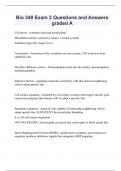
Package deal for bio 348 exam questions and answers 2024
Package deal for bio 348 exam questions and answers 2024
- Package deal
- • 5 items •
- Bio 348 Exam 2 Questions and Answers graded A • Exam (elaborations)
- BIO 348 Muscles study guide questions and answers • Exam (elaborations)
- Bio 348 Exam 1 Ultimate Study Guide quizzes • Exam (elaborations)
- bio 348 exam questions and answers 2024 • Exam (elaborations)
- Bio 348 Drexel study guide questions and answers • Exam (elaborations)
Package deal for bio 348 exam questions and answers 2024
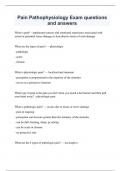
Pain Pathophysiology Exam questions and answers
What is pain? - unpleasant sensory and emotional experience associated with actual or potential tissue damage or described in terms of such damage What are the types of pain? - - physiologic - pathologic - acute - chronic What is physiologic pain? - - localized and transient - perception is proportional to the intensity of the stimulus - serves as a protective function What type of pain is the pain you feel when you touch a hot burner and then pull your hand away? - physiologic pai...
- Exam (elaborations)
- • 7 pages •
What is pain? - unpleasant sensory and emotional experience associated with actual or potential tissue damage or described in terms of such damage What are the types of pain? - - physiologic - pathologic - acute - chronic What is physiologic pain? - - localized and transient - perception is proportional to the intensity of the stimulus - serves as a protective function What type of pain is the pain you feel when you touch a hot burner and then pull your hand away? - physiologic pai...
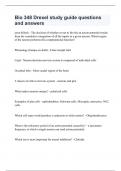
Bio 348 Drexel study guide questions and answers
axon hillock - The decision of whether or not to fire the an action potential results from the cumulative integration of all the inputs to a given neuron. Which region of the neuron performs this complutational function? Phrenology (bumps on skull) - Franz Joseph Gall Cajal - Neuron doctrine-nervous system is composed of individual cells Occipital lobe - Most caudal region of the brain 2 classes of cells in nervous system - neurons and glia What makes neurons unique? - polarized c...
- Package deal
- Exam (elaborations)
- • 10 pages •
axon hillock - The decision of whether or not to fire the an action potential results from the cumulative integration of all the inputs to a given neuron. Which region of the neuron performs this complutational function? Phrenology (bumps on skull) - Franz Joseph Gall Cajal - Neuron doctrine-nervous system is composed of individual cells Occipital lobe - Most caudal region of the brain 2 classes of cells in nervous system - neurons and glia What makes neurons unique? - polarized c...
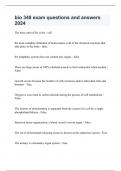
bio 348 exam questions and answers 2024
The basic unit of life is the - cell the most complete definition of homeostasis is all of the chemical reactions that take place in the body - false the lymphatic system does not contain any organs - false There are large stores of ATP in skeletal muscle to fuel contraction when needed - False Growth occurs because the number of cells increases and/or individual cells add biomass - True Oxygen is converted to carbon dioxide during the process of cell metabolism - False The int...
- Package deal
- Exam (elaborations)
- • 5 pages •
The basic unit of life is the - cell the most complete definition of homeostasis is all of the chemical reactions that take place in the body - false the lymphatic system does not contain any organs - false There are large stores of ATP in skeletal muscle to fuel contraction when needed - False Growth occurs because the number of cells increases and/or individual cells add biomass - True Oxygen is converted to carbon dioxide during the process of cell metabolism - False The int...
